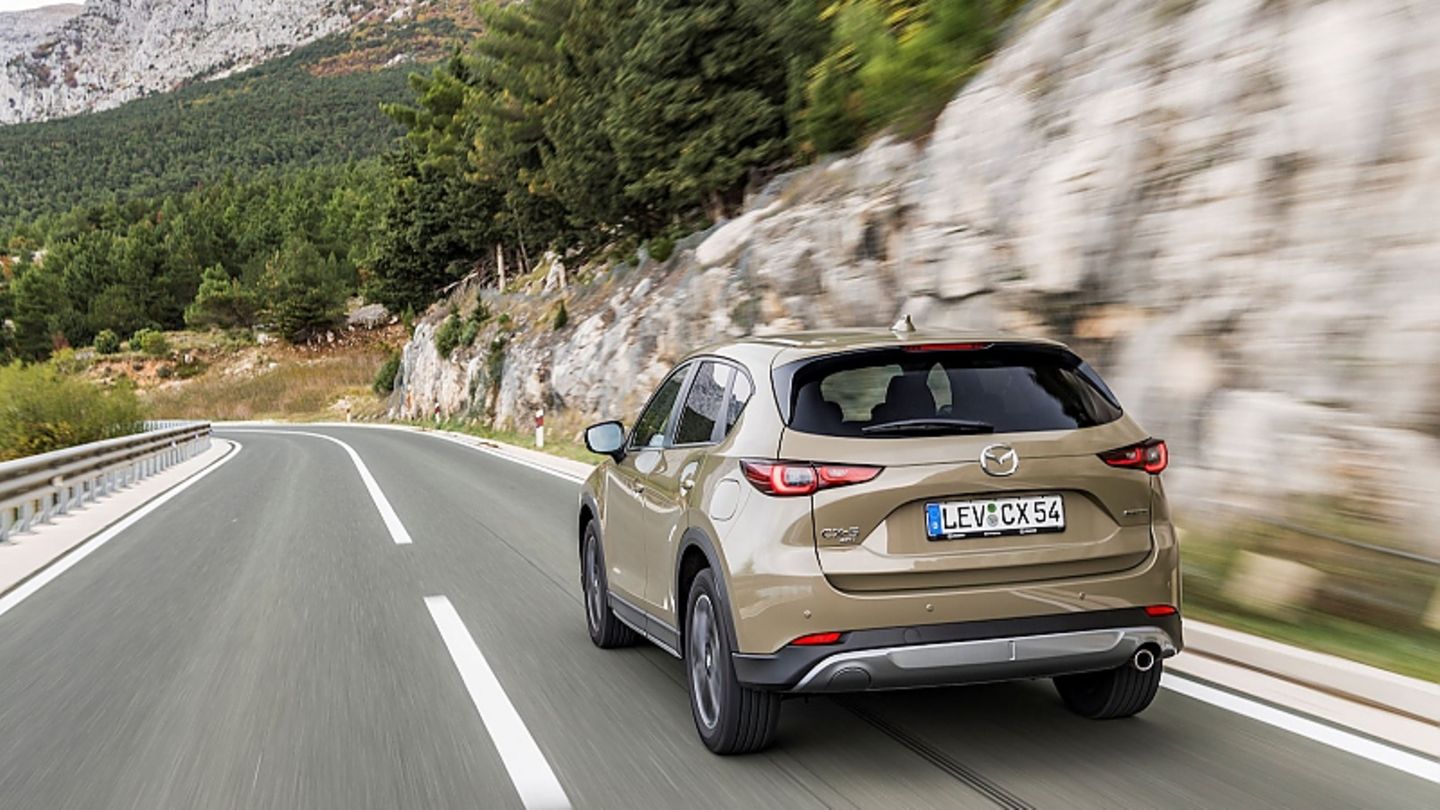What works well should not be changed unnecessarily. According to this motto, Mazda is giving its SUV CX-5 a careful facelift.
Since MAZDA launched the CX-5 ten years ago, the SUV has become one of the most successful models of the Japanese. A good 3.53 million units have rolled off the assembly line since then. In Europe, every fifth Mazda sold is a CX-5, in Germany it is now the second most popular model of the brand. In 2021, almost 7,500 CX-5s were newly registered in Germany.
There are many reasons for the success of the Mazda flagship. This starts with the stylish Kodo design with its concise shadowed edges and leads to the high long-term quality. In the vehicles up to nine years old, the Mazda CX-5 is in fourth place in the TÜV defect report – behind two Mercedes and one Audi. In addition, there is a solid impression: with a length of 4,575 mm, it is shorter than a VW Golf, but not only looks larger and more massive, but also offers significantly more space.
The model update of the second generation, which started in 2017, is correspondingly cautious. Above all, it’s the details that the designers have worked on. Example front. The grille with the wing logo now has a much more three-dimensional look. The headlights are narrower again, their LED matrix light has been further developed and now has 20 instead of the previous twelve LED light blocks. The LEDs can be controlled individually to brightly illuminate the road without dazzling oncoming traffic. Mazda has also redesigned the rear lights.
Inside, CX-5 customers can find their way around straight away: everything is where it belongs. Depending on the equipment, there is now a charging cradle for the cell phone in the center console. As usual, the 10.25-inch display sits on the dashboard and can be operated using the rotary handle on the center console or by voice control. Optionally, you can also order a head-up display that projects its information easily legible onto the windscreen. A new driving mode switch can be used in the models with automatic and all-wheel drive to adapt the driving behavior of the CX-5 to your own preferences, including off-road mode. It should also improve driving with a trailer – braked up to 2,000 kg, unbraked 750 kg can be towed. In the second row there is plenty of space for taller passengers – in front of their knees as well as over their heads. The floor in the luggage compartment, which has grown slightly to 522 liters and can be expanded to 1,638 liters, can be fixed at two heights. There is also an additional storage compartment under the trunk floor. A traffic jam assistant with acceleration, braking and steering functions has been added to the assistance systems.
Little has changed with the Skyactiv engines either. The two four-cylinder petrol engines deliver 165 hp / 121 kW and 194 hp / 143 kW respectively and meet the requirements of Euro 6d even without a particle filter. In the petrol engines, cylinder deactivation reduces thirst. The switch itself is not noticeable when driving. The 194 hp petrol engine has an official WLTP consumption of 8.1 to 7.6 liters per 100 kilometers, which corresponds to CO2 emissions of 184 to 171 g/km. In the automatic version, the top petrol engine has a system on board as standard that recovers energy when braking. The “small” petrol engine consumes 6.8 l/100 km with front-wheel drive and 7.8 to 7.6 liters with all-wheel drive.
Good, if not exactly lively on the road you are with both petrol engines. This is not least due to the curb weight of a good 1.6 tons. Even the 194 hp petrol engine with its 258 Nm maximum torque officially needs at least nine seconds from zero to 100 km/h. It doesn’t have to be more fixed either: The CX-5 is a crossover that is more inviting for cruising, for relaxed travel and not a fast cornering athlete. The cultivated running turbo diesel is available with 150 hp / 110 kW or 184 hp / 135 kW. Among other things, an SCR system with urea injection ensures exhaust gas purification. The top version of the 2.2-liter diesel consumes 5.6 l/100 km, with 150 hp it is 5.6 l/100 km. All engines can be combined with front or all-wheel drive and with a precisely acting six-speed manual transmission or an amazingly superior six-speed automatic converter. With all-wheel drive, 100 percent of the power is sent to the front wheels in normal road use; on difficult terrain, the power distribution is automatically controlled by 27 sensors, with a maximum of 50 percent going to the rear.
The chassis was revised with MacPherson suspension at the front and multi-link axle at the rear. Skyactiv-Vehicle Architecture calls this Mazda. Bodywork, wheel suspension and seats are included. The goal is fatigue-free driving, even over long distances, and a reduction in road noise. However, the less driving noise is quickly made up for by the volume of the engine when accelerating hard. The chassis keeps the CX-5 confidently on the road. Bumps in the asphalt are smoothed out without hesitation, driving comfort is high. In the precisely extendable curves, the SUV only has a minimal tendency to roll over. There is also precise steering.
In the cheapest version with a 165 hp petrol engine, manual switch and front-wheel drive, Mazda offers the CX-5 from 28,290 euros. The more powerful petrol engine is available with front-wheel drive from 36,390 euros, with all-wheel drive from 38,390 euros. The diesels start at 34,090 euros. The top model is the 184 hp diesel with all-wheel drive and automatic in the Sports Line Plus equipment from 47,840 euros.
Source: Stern
I am a 24-year-old writer and journalist who has been working in the news industry for the past two years. I write primarily about market news, so if you’re looking for insights into what’s going on in the stock market or economic indicators, you’ve come to the right place. I also dabble in writing articles on lifestyle trends and pop culture news.




